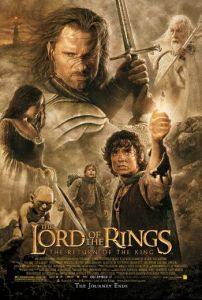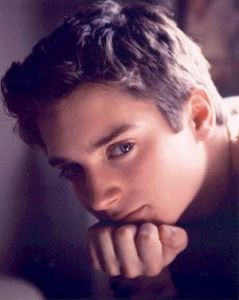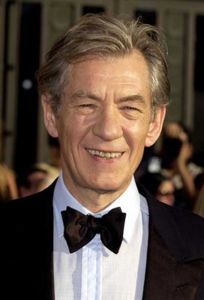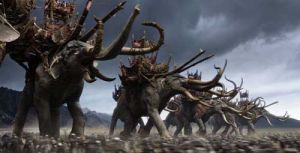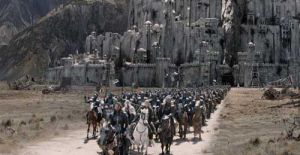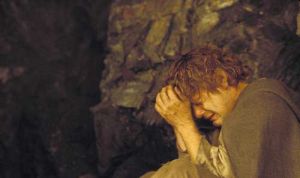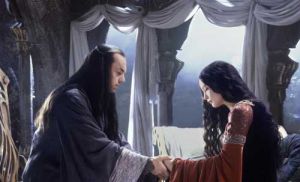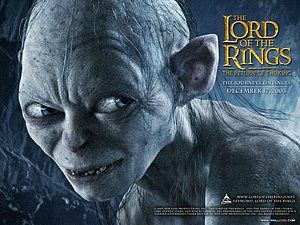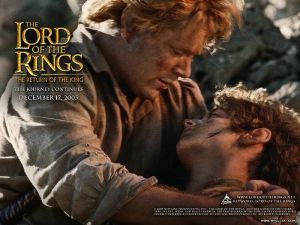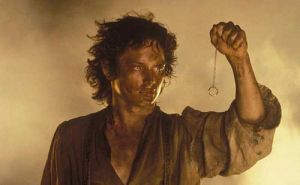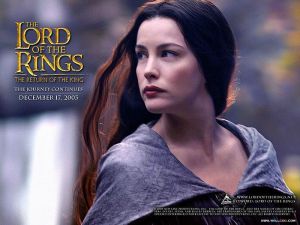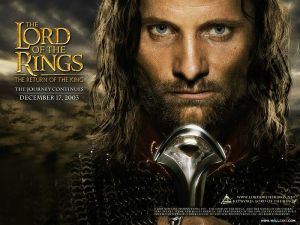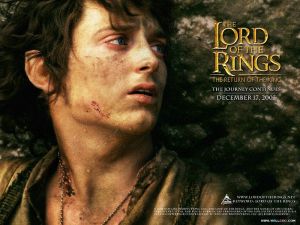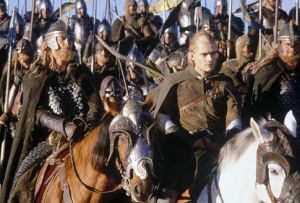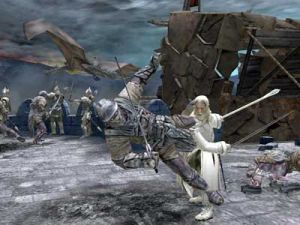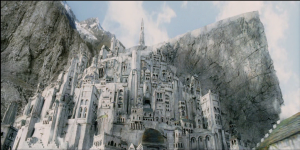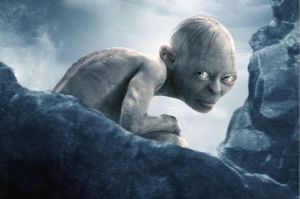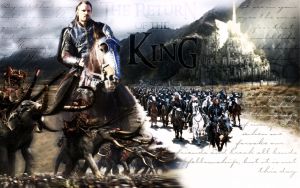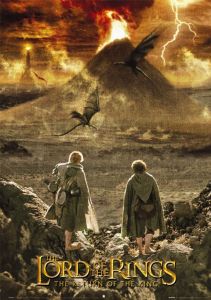The Return of the King 王者归来/王者无敌
The Return of the King(王者归来又称王者无敌)is a 2003 fantasy-adventure film directed by Peter Jackson adapted from the third volume of J. R. R. Tolkien's The Lord of the Rings. Released on December 17, 2003, The Return of the King became one of the greatest box-office successes of all time. It won all eleven Academy Awards for which it was nominated. However, it won 11 out of 11 Academy Awards when Ben-Hur won 11 out of 12, and Titanic won 11 out of 14. It also won the Academy Award for Best Picture, the only time in history a fantasy film has done so. It is the third highest-grossing film of all time worldwide, behind Avatar and Titanic.
Directed by: Peter Jackson
Produced by: Peter Jackson Barrie M. Osborne Fran Walsh
Written by: Fran Walsh Philippa Boyens Peter Jackson
Music by: Howard Shore
Cinematography: Andrew Lesnie
Editing by: Jamie Selkirk Annie Collins
Distributed by: New Line Cinema
Release dates:
December 1, 2003 (Wellington premiere)
December 17, 2003 (United Kingdom) (United States)
December 18, 2003 (New Zealand)
Running time: 200 minutes
Country: New Zealand United States United Kingdom
Language: English
Genre: Action Adventure Fantasy
Elijah Wood as Frodo Baggins: The Hobbit who continues his quest to destroy the Ring, which continues to torture him.
Sean Astin as Samwise Gamgee: Better known as Sam, he is Frodo's loyal Hobbit companion.
Viggo Mortensen as Aragorn: Aragorn must finally face his destiny as King of Gondor.
Ian McKellen as Gandalf the White: The Wizard who travels to aid the Men of Gondor, acting as a general at the Siege of Gondor.
Orlando Bloom as Legolas: An Elven prince and skilled archer; one of Aragorn's best friends.
Dominic Monaghan as Meriadoc Brandybuck: Better known as Merry, the Hobbit who becomes an esquire of Rohan.
Billy Boyd as Peregrin Took: Better known as Pippin, a Hobbit who looks into the palantír and becomes an esquire of Gondor.
John Rhys-Davies as Gimli: The warrior Dwarf who continues his friendly rivalry over Orc kills with Legolas. Rhys-Davies also voices Treebeard the Ent leader.
Bernard Hill as Théoden: King of Rohan. After triumphing at Helm's Deep, he is preparing his troops for the Battle of the Pelennor Fields. He is the uncle of Eomer and Eowyn.
Miranda Otto as Éowyn: Théoden's niece, who wishes to prove herself in battle. She also starts to fall in love with Aragorn, who does not return her love. In the extended version, she finds love with Faramir when they are both residing in the Houses of Healing.
Karl Urban as Éomer: Éowyn's brother, and Chief Marshal of the Riders of Rohan. Nephew to King Theoden.
Hugo Weaving as Elrond: The Elven lord of Rivendell who must convince Aragorn to take up the throne.
Liv Tyler as Arwen, daughter of Elrond, Aragorn's lover. She becomes sick with grief.
David Wenham as Faramir: The head of the Gondorian Rangers defending Osgiliath. Second-born son to Denethor, he seeks his father's love in vain.
John Noble as Denethor: Steward of Gondor and father to Faramir, as well as the slain Boromir. Due to grief over Boromir's death, and despair over Mordor's superior numbers, he falls into madness during the Siege of Gondor.
Bruce Hopkins as Gamling: Right-hand man of Théoden and a skilled member of the Royal Guard of Rohan.
Paul Norell as The King of the Dead: The cursed leader of the Dead Men at Dunharrow, from whom Aragorn must seek help.
Ian Holm as Bilbo Baggins: Frodo's elderly uncle, who has rapidly aged after giving away the ring.
Marton Csokas as Lord Celeborn: Elven lord of Lórien.
Andy Serkis as Sméagol
Thomas Robins as Déagol, Sméagol's cousin.
Sarah McLeod as Rosie Cotton: The girl of Sam's dreams.
In the opening scene, Sméagol and his friend Déagol are fishing near the Gladden Fields in the North of Middle Earth. Déagol is dragged into the river by a powerful catch and discovers the One Ring glinting in the river bed. He collects it and climbs out of the river. Sméagol sees him fondling it and as they both succumb to the Ring's power they begin to quarrel. Sméagol demands it saying that it's his birthday and it should be his present. The squabble turns into a fight and Sméagol strangles his friend with his bare hands to finally prise the Ring from his clenched fist. We are then shown how Sméagol was ostracised from his community and driven away. Suffering terribly from his loneliness and shame, Sméagol takes solice in his love for the Ring as it slowly tortures his mind. His hardships in the Mountains twist his shape into that of Gollum.
As the flashback ends, we are taken back to the present where, on the outskirts of Mordor, Frodo and Sam are resting in an alcove. Sam awakes and sees that his master has not slept, the days are also growing darker and closer they get to Mordor. Gollum arrives and urges them to move on. Away in the west, Aragorn, Legolas, Gimli, Gandalf, Théoden and Éomer are riding through Fangorn to Isengard, where they meet Merry and Pippin feasting among the wreckage of Isengard. They then go and see Treebeard at the Orthanc where Saruman has been trapped. The group then rides to Edoras, where King Théoden has prepared a feast to 'hail the victorious dead' of the Battle of the Hornburg. Gandalf expresses to Aragorn his concerns over the quest, Aragorn tells him to trust in what his heart tells him, that Frodo is still alive.
Gollum awakes in the night as Frodo and Sam are sleeping and goes off to one side to murmur to himself. His evil half senses some doubt in Sméagol and insists that if he can murder once. Gollum then begins leading Sméagol through their plan, to deliver the hobbits into the clutches of Shelob in Cirith Ungol, after which the Ring can be reclaimed. Sam hears this and proceeds to beat Gollum for his treachery, Frodo intervenes, saying that as their guide Gollum is necessary for their quest. Sam obliges as Gollum flashes him an evil smile while Frodo's back is turned.
Leaving Rivendell on her way to the Undying Lands, Arwen has a vision of her son by Aragorn, she realises that her father lied to her about there being no chance of a future with him whom she loves. She returns to Rivendell and convinces Elrond that she, having foresaken the life of the Eldar, cannot leave Aragorn now. She tells her father that as was declared in lore, the time to reforge Narsil has come, Narsil being the sword of Elendil that cut the Ring from Sauron's finger long ago at the end of the Second Age.
The Morgul army crosses Anduin at Osgiliath in makeshift boats and engages the Gondorian contingent in battle. The orcs prove too strong and drive the Gondorians out of Osgiliath, Faramir and his few surviving men retreat to Minas Tirith, pursued by the Nazgûl. Gandalf, riding out to meet the retreating men, wards them off, saving Faramir. Upon his arrival, Faramir tells Gandalf of the dangerous route Gollum is taking Frodo and Sam on, convincing Gandalf of Gollum's treachery. The hobbits, lead by Gollum, are struggling to climb the extremely steep stairs, Gollum reaches out and empathises with Frodo, saying that he understands his pain, and also poisoning him against Sam, saying that he will try and take the Ring from Frodo.
In the captured Osgiliath, the Witch-king orders his captain to "send forth all legions" and annihilate the population of Minas Tirith. The attack is destroyed and Faramir is dragged back by his horse in a death-like coma. At the weapon-take of Dunharrow, a hooded figure slowly rides on a white horse along the winding road to the encampment in the hills. The figure reveals himself to Aragorn as Elrond. He presents Aragorn with his birthright, Flame of the West. He urges Aragorn to use this sword, forged from the shards of Narsil, to recall the Dead Men of Dunharrow and use their allegiance to the heir of Isildur (i.e. Aragorn) to stop the attack of the Corsairs ships from the south. Aragorn accepts this counsel and rides off that very night into the Dimholt, along with Legolas and Gimli.
The Morgul forces, composed mostly of Orcs, begin the siege of Minas Tirith using the heads of caputured prisoners as catapult projectiles. Denethor sees his son and believes him to be dead, he also beholds the might of the forces marshalled against him and at this he loses control and hope, ordering the Gondorians to abandon their positions. Gandalf however, steps in and incapacitates Denethor, and then proceeds to assume control of the defence. A skirmish between Gondorian trebuchets and Mordor catapults ensues until the Witch-king and the other Ringwraiths on their Fell Beasts attack, destroying the catapults and sowing terror among the defenders. Away in Cirith Ungol, Gollum betrays Frodo to the spider creature Shelob, but Sam returns to fight her off. Sam believes Frodo is dead, but when Orcs from the Tower of Cirith Ungol come and investigate, Sam overhears that Frodo has only been paralysed by Shelob's stinger.
Sam rescues Frodo from Cirith Ungol, which is mostly empty following a fight between the two factions of the Tower's Orc garrison over Frodo's mithril shirt, and they begin the long trek across Mordor to Mount Doom. Gandalf realizes that ten thousand Orcs stand between Cirith Ungol and Mount Doom, which will prevent Frodo from reaching his destination. Aragorn proposes they lead the remaining soldiers to the Black Gate to draw the Orcs away from Frodo's path, as well as distract the Eye of Sauron. Sam carries Frodo up to Mount Doom, but Gollum arrives and attacks them, just as the Battle of the Morannon begins. At the Crack of Doom, Frodo, instead of dropping the ring into the Fire, succumbs to its power and puts it on, disappearing from sight. Gollum renders Sam unconscious then attacks Frodo, seizing his ring finger and biting it off. As Gollum rejoices at finally havng reclaimed his Precious, Frodo, still under the sway of the Ring's attraction, charges at Gollum. After a brief struggle, they both fall over the edge of the precipice. Gollum falls into the Fire with the Ring, while Frodo barely hangs on with his strength failing. Sam rescues Frodo as the Ring finally sinks into the lava and is destroyed. The Tower of Barad-dûr collapses, Sauron's essence fades and then explodes, forever banishing his power. The Orcs, Ringwraiths and the remaining forces of Sauron are consumed in the ensuing shockwave as the earth collapses under their feet. Frodo and Sam are stranded as Mount Doom erupts. They voice their regrets at not being able to see the Shire again amidst the torrents of lava and the destruction of Barad-dur. With the destruction of the Nazgul, Gandalf is able to call upon the Eagles to carry the hobbits to safety, they awake in Minas Tirith, reuniting with the other members of the fellowship, all of them having survived the War of the Ring.
Aragorn is crowned King of the West, heralding the new age of peace, and is reunited with Arwen. The hobbits return to the Shire, where Sam marries Rosie Cotton. Frodo, having finished writing his entry in the Red Book of Westmarch, is still suffering from the effects of the ring, having possessed it for so long. He realises that he will never have peace in Middle-earth. So he decides to go with Gandalf, Bilbo, Elrond and Galadriel to the Grey Havens. There he passes the Red Book onto Sam to record the years of his life to come, and thence the last ship to leave Middle-earth sets off, pulling slowly away from the shore and passing along the Straight Road into the Uttermost West. Pippin and Merry take their leave and Sam is left staring into the golden sunset. In the last scene, Sam is shown walking back up the lane to Bag End, where he is greeted by Rosie his wife and his children, surrounded by his family and with the rest of his life ahead of him, Sam sighs and says "Well, I'm back", then he goes inside and shuts the door as the screen fades to black.
The film contains major scenes that occurred in the middle portion of the novel. In the film, Saruman drops the palantír, whereas in the book Gríma throws it at the Fellowship, unaware of its value.Denethor, the Steward of Gondor was a more tragic character in the book. The film only focuses on his overwhelming grief over the death of Boromir as to ignore Sauron's threat and is driven over the edge by Faramir's injury. The romance that develops between Éowyn and Faramir during their recoveries in the Houses of Healing is also largely cut, presumably to keep the focus on Aragorn and Arwen; the subplot is only briefly referenced in the Extended Edition with a scene where the two hold hands.
Sam and Frodo's major rift in their friendship, due to Gollum's machinations, never takes place in the book, but was added by the writers in believing that it added drama and more complexity to the character of Frodo. Frodo enters Shelob's lair alone in the film, whereas in the book he and Sam entered together. This was done to make the scene more horrific with Frodo being alone, and Sam's rescue at the last minute more dramatic. Also, in the film we don't know that Sam has the ring until he gives it back to Frodo, whereas in the book the reader knows that Sam has the ring. Gollum's fall into the lava of Mount Doom was also rewritten for the film, as the writers felt Tolkien's original idea was anti-climactic. Originally, an even greater deviation was planned: Frodo would heroically push Gollum over the ledge to destroy him and the Ring, but the production team eventually realized that it looked more like Frodo murdering Gollum. As a result, they had Frodo and Gollum struggle for possession of the Ring and both slip over the edge by accident.
There are several changes in the Battle of the Black Gate. Merry is not present there in the book, Pippin does not kill a troll as he does in the novel, and Aragorn kills the Mouth of Sauron in the extended edition of the film but not in the book. There was an even larger change planned: Sauron himself would come out in physical form to battle Aragorn, who would only be saved by the destruction of the Ring. Jackson eventually realized it ignored the point of Aragorn's true bravery in distracting Sauron's army against overwhelming odds, and a computer generated Troll was placed over footage of Sauron in the finished film. The ending is streamlined so as not to include the Scouring of the Shire, which was always seen by the writers as anti-climactic. It is referenced, though, in Frodo's vision of the future in Galadriel's mirror in The Fellowship of the Ring.
Middle-earth was primarily designed by Alan Lee and John Howe and created by Weta Workshop, who handled all the trilogy's weapons, armour, miniatures, prosthetics and creatures, as well as the Art Department which built the sets. Richard Taylor headed Weta, whilst Grant Major and Dan Hennah organized the planning and building respectively.
There was also the Citadel, the exterior of which was in the Stone Street Studios backlot, using forced perspective. It contains the withered White Tree, built from polystyrene by Brian Massey and the Greens Department with real branches, influenced by ancient and gnarled Lebanese olive trees. The interior was within a 3 story former factory in Wellington, and colour wise is influenced by Charlemagne's Chapel, with a throne for Denethor carved from stone and polystyrene statues of past Kings. The Gondorian armour is designed to represent an evolution from the Númenóreans of the first film's prologue, with a simplified sea bird motif. 16th century Italian and German armour served as inspiration, whilst civilians wear silver and blacks as designed by Ngila Dickson, continuing an ancient Mediterranean Basin look.
Minas Morgul, the Staircase and Tower of Cirith Ungol as well as Shelob's Lair were designed by Howe, with the Morgul road using forced perspective into a bluescreened miniature. Howe's design of Minas Morgul was inspired from the experience of having wisdom teeth pulled out: in the same way, the Orcs have put their twisted designs on to a former Gondorian city. The interior set, like Minas Tirith, was built as a few multiple levels that numerous camera takes would suggest a larger structure.
The third film introduces the enormous spider Shelob. Shelob was designed in 1999, with the body based on a tunnelweb spider and the head with numerous growths selected by Peter Jackson's children from one of many sculpts. Jackson himself took great joy in planning the sequence, being an arachnophobe himself. Shelob's Lair was inspired by sandstone and sculpted from the existing Caverns of Isengard set.
The Return of the King was shot during 2000 and Sean Astin's coverage from Gollum's attempt to separate Frodo and Sam was filmed on 24 November 1999. Some of the earliest scenes shot for the film were in fact the last. Hobbiton, home of the Hobbits, was shot in January 2000 with early scenes from The Fellowship of the Ring, with the exterior shot at a Matamata farm, whilst interior scenes shot at Stone Street Studios in Wellington, shared with the Grey Havens sequence. Due to the high emotions of filming the scene, the cast were in despair when they were required to shoot it three times, due to a costume continuity flaw in Sean Astin's costume, and then negatives producing out-of-focus reels.
The Battle of the Black Gate was filmed in April at the Rangipo Desert. New Zealand soldiers were hired as extras whilst guides were on the look out for unexploded mines. Also a cause for concern were Monaghan and Boyd's scale doubles during a charge sequence. In the meantime, Wood, Astin and Serkis filmed at Mount Ruapehu for the Mount Doom exteriors. In particular, they spent two hours shooting Sam lifting Frodo on to his back with cross-camera coverage.Scenes shot in June were the Paths of the Dead across various locations, including Pinnacles.In July the crew shot some Shelob scenes, and in August and September time was spent on the scenes in Isengard.
Edoras exteriors were shot in October. The Ride of the Rohirrim, where Théoden leads the charge into the Orc army, was filmed in Twizel with 150 extras on horseback. The Battle of the Pelennor Fields has more extensive use of computer-generated imagery, in contrast to the more extensive use of live action in the Battle of Helm's Deep in the second film. Also filmed were the attempts by Faramir to recapture Osgiliath, as were scenes in the city itself. At this point production was very hectic, with Jackson moving around ten units per day, and production finally wrapped on the Minas Tirith sets, as well as second units shooting parts of the siege.
The music was composed by Howard Shore, who previously composed the first two parts of the trilogy. Shore watched the assembly cut of the film, and had to write seven minutes of music per day to keep up with the schedule. The score sees the full introduction of the Gondor theme.
Renée Fleming, Ben Del Maestro and James Galway also contribute to the soundtrack. Fleming sings as Arwen has a vision of her son and when Gollum recovers the One Ring. Del Maestro sings when Gandalf lights his staff to save fleeing Gondorian soldiers from Osgiliath as the Nazgûl attack. Galway plays the flute as Frodo and Sam climb Mount Doom. The end title song, "Into the West", was composed by Shore with lyrics by Fran Walsh. Annie Lennox performed it and also received songwriting credit. The song was partially inspired by the premature death from cancer of a young New Zealand filmmaker named Cameron Duncan who had befriended Peter Jackson.
The Sound department spent the early part of the year searching for the right sounds. A tasmanian devil was Shelob's shriek, which in turn gave inspiration for Weta's animators, whilst the mûmakil is the beginning and end of a lion roar. For missile trading during Minas Tirith's siege, construction workers dropped actual 2 ton stone blocks previously lifted by a construction crane. Mixing began at a new studio on 15 August, although unfinished building work caused some annoyances. The mixers finished on 15 November, after three months of non-stop work.
After Frodo wakes up in Minas Tirith, Merry and Pippin stand in the doorway. Their height reaches the middle of the ornate door carving in the close-up, but in their next wide shot running in, they are considerably lower. When Legolas and Aragorn walk in, also in a close-up, their height is just a bit higher on the carving than the two Hobbits' heights were. Then when Sam stands in the doorway his height also reaches the center of the carving.
At the end, when the four Hobbits are entering Grey Havens, Sam is wearing a yellow vest with brown buttons over a white shirt. When Frodo makes his way onto the ship and turns back to smile at his friends, Sam is no longer wearing the yellow vest. The vest is still not there when the three Hobbits turn to leave the Grey Havens. When Sam is holding his daughter, he is once again wearing the yellow vest.
After Pippin draws his sword, the next shot is of Orcs running to the right of the screen. As that shot opens, click five or six frames in and two crewmembers are seen between the Orcs on the right of the screen, click a few more times and more crew members are visible in the middle, between the Orcs.
The film received nearly universal acclaim from most critics. The main criticism of The Lord of the Rings: The Return of the King, was its running time, particularly the epilogue. Even rave reviews for the film commented on its length. There was also criticism regarding the Army of the Dead's appearance, rapidly ending the Battle of the Pelennor Fields.
"It is the best film of the year."
—Richard Corliss of Time
"If it didn't take forty-five minutes to end, it'd be my best picture of the year. As it is, it's just one of the great achievements in film history."
—Joel Siegel of Good Morning America
"Since all three epics were filmed simultaneously, each individually has the feel of being part of a larger picture — except for this one. "The Return of the King" is just too big, the most epic of a set of epic films. Now that director Peter Jackson has brilliantly constructed the characters and plotlines throughout the first two films, he puts them to use."
"The real acting triumph of the film is Elijah Wood as Frodo Baggins. He continues his descent into corruption with an incredible talent that many could not pull off. Wood's performance is so critical to the film because it determines the ring's power to corrupt, which, needless to say, is absolute."
No.8 on Empire's 100 Greatest Movies of All Time
No.3 of the past decade (Total Film's publication time)by Total Film
Academy Awards
Best Picture
Directing
Adapted Screenplay
Original Score
Song
Visual Effects
Art Direction
Costuming
Make-up
Sound Mixing
Film Editing
Globle Awards
Best Picture for Drama
Best Director
New York Film Critics Circle award
Best Picture
Nebula Award
Best Script
Hugo Award
Best Dramatic Presentation, Long Form.
附件列表
词条内容仅供参考,如果您需要解决具体问题
(尤其在法律、医学等领域),建议您咨询相关领域专业人士。
如果您认为本词条还有待完善,请 编辑
上一篇 梅雪——风光在英语讲台的舞蹈硕士 下一篇 改错练习(三)

